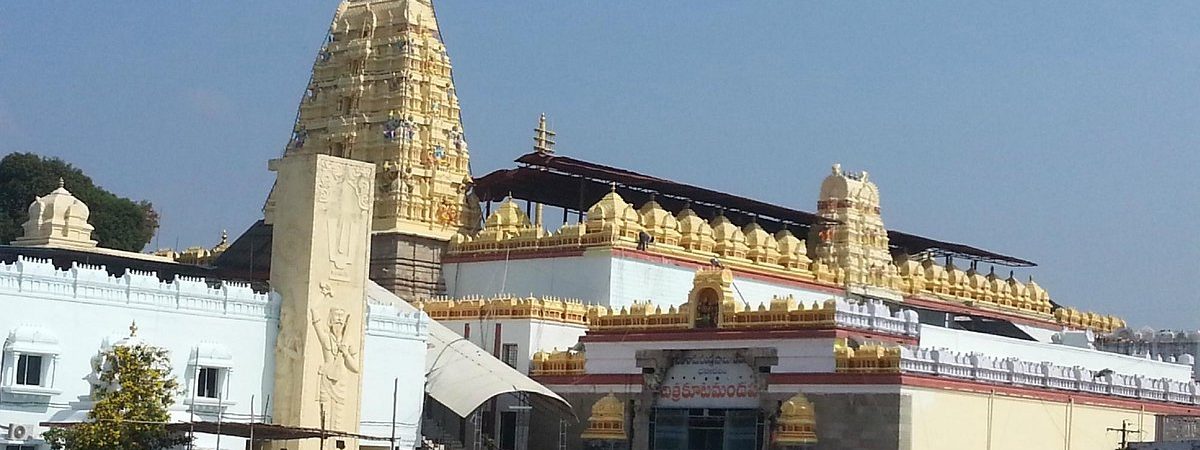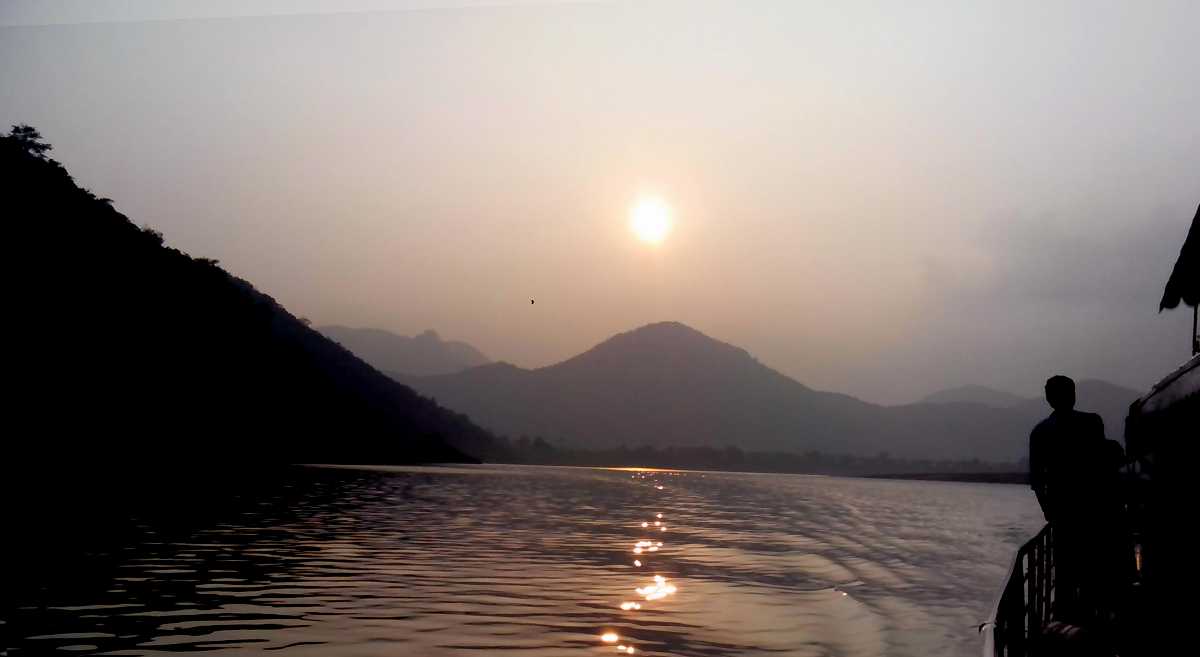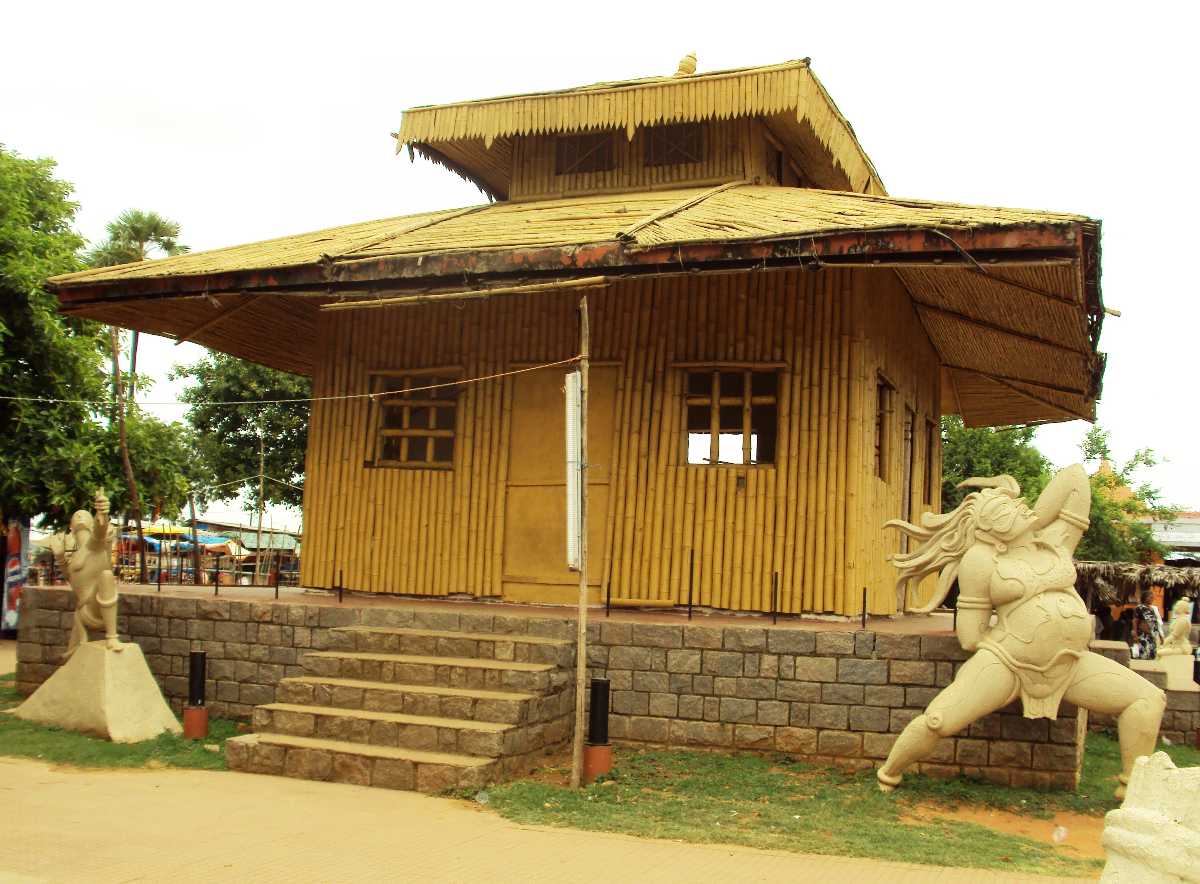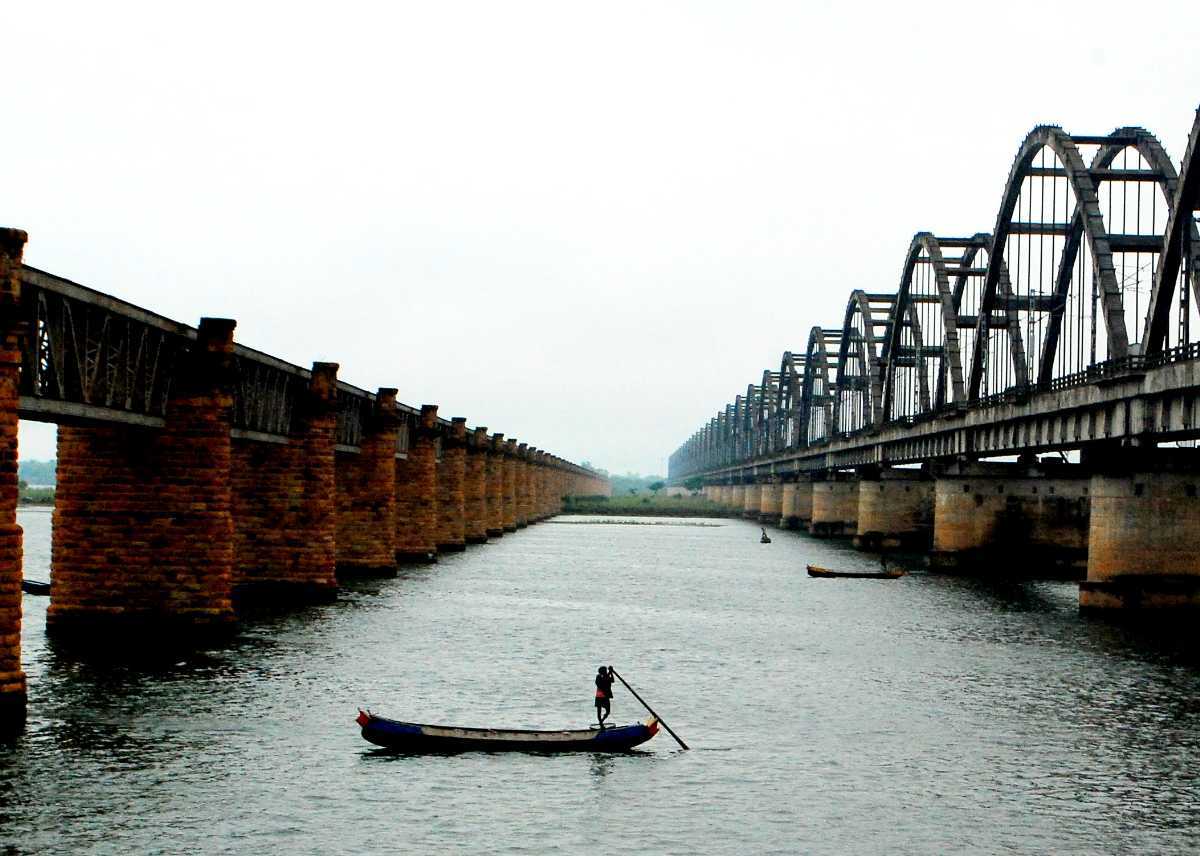Complete Guide about Bhadradri Sita Ramachandraswamy Temple
-
Location
Bhadrachalam Temple - Bhadradri Sita Ramachandraswamy Devasthanam MV8M+P25, Bhadrachalam, Telangana 507111
-
Timings
Every Day
04:30 am to 01:00pm
03:00 pm to 09:00pm -
Entry Fee
No Entry fee


Bhadradri Sita Ramachandraswamy Temple
Bhadradri Sita Ramachandraswamy
On the left bank of the Godavari River stands the Sree Seetha Ramachandra Swamy shrine at Bhadrachalam, the most well-known temple in the nation dedicated to Lord Rama. Hindus visit this location because it is one of the most important holy sites in South India, and it has a fascinating history. The temple was built in the 17th century by the ardent Lod Sree Rama devotee and local tahsildar Kancharla Gopanna, also known as Bhakta Ramadas.
According to puranic and historical accounts, Lord Rama appeared long after he had shed his mortal coils in order to save Bhadra Maharshi, a devotee to whom he had promised “moksha” after many prayers. Because of this, the village is called Bhadradri or Bhadrachalam, after Bhadra. Srirama told Pokala Dammakka about the vigrahas on the Bhadragiri hills when he appeared to her in a dream. She was surprised to discover the “Vigrahas” and erected a little hut. This was how the current temple got its start.
Vaikom Mahadeva Temple Official website Link
www.vaikomtemple.org
The History
It is the home of Lord Rama, a holy spot that draws tens of thousands of worshippers from all over the world (The seventh incarnation of SriMahavishnu). The holy river Godavari surrounds this hill, which is where the famed shrine Bhadrachalam, which takes its name from Bhadragiri, is located (Mountain of Bhadra-a boon child of Meru and Menaka). The importance of this shrine dates back to the Ramayana Era, according to an Ithihasa. The Ramayana’s “Dandakaranya” period included this beautiful hill where Rama, his wife Sita, and brother Laxmana spent their vanavasa. Parnashaala, the location of the fabled Golden Deer and the location from whence Sita was kidnapped by Ravana, is also close by.Long after Ramavatara, Bhagawan Mahavishnu appeared as Rama once again at this Mandir location to keep a promise He made to His Bhakta Bhadra, who continued his Tapas through the Yugas while pleading for the blessings of the Bhagawan Sri Ramachandra murthy.
According to legend, Vykuntha Rama’s incarnation was necessary in order to satisfy the long-standing wish of his devoted disciple Bhadra.
About Bhadra Maharshi
The exulted “Rishi” begged Rama to be seated on his head, but Rama, who was searching for his consort Sita, promised to his Bhakta that his desire would be fulfilled on his way back, after finding Sita and completing the process of punishing the wicked Ravana and establishing “Dharma.” Bhadra performed penance at the bank of the river Godavari in this “Dandakaranya” to get the grace of Lord Rama and As a result, the sage had continued his terrified penance because Rama had failed to keep his promise made in the Ramavatara.
Then, Sri Mahavishnu appeared as Vykuntha Rama and hurried to his devotee Bhadra, proclaiming his presence by blowing “Shanku,” with his companion Sita and brother Laxmana, like that of “Gajendra Moksham”-style liberation. As a result, Rama’s four-handed moorthies—Shanku on the right, Chakra on the left, and Dhanurbhana—as well as Sita’s descent onto his left lap and his brother’s position on his left—are real. The hill where the Deities were seated was also the head of Bhadra-achalam (hill), which is how this shrine came to be known as Bhadrachalam.
Pokala Dhammakka unearthed the idols of Vykuntha Rama, Laxmana, and Sita. A mile away from this sacred site, in the 17th century, Pokala Dhammakka, an ardent Rama follower, resided in Bhadrireddypalem. The saints and sages are worshipping my embodied moorthy situated on Bhadragiri, Rama told her in her dream one wonderful night. He urged her to find them, perform pooja, and find salvation. The idols were hidden there when she peered into an anthill the very next morning while hunting for them. She doused the anthill with hundreds of pots of Godavari water, which eventually disintegrated and made room for the concealed Deities to manifest.Pokala Dhammakka unearthed the idols of Vykuntha Rama, Laxmana, and Sita. A mile away from this sacred site, in the 17th century, Pokala Dhammakka, an ardent Rama follower, resided in Bhadrireddypalem. The saints and sages are worshipping my embodied moorthy situated on Bhadragiri, Rama told her in her dream one wonderful night. He urged her to find them, perform pooja, and find salvation. The idols were hidden there when she peered into an anthill the very next morning while hunting for them. She doused the anthill with hundreds of pots of Godavari water, which eventually disintegrated and made room for the concealed Deities to manifest.
Temple Constructed by Bhakta Ramadasu
In the year 1674 A.D., Kancharla Gopanna, also known as Bhakta Ramadas, built the Bhadrachalarama Temple.
A devoted follower of Rama known as “Bhakta Ramdas” and the son of Linganna Murthy and Kamamba, Kancharla Gopanna was born in the 17th century in the Khammamett Taluk hamlet of Nelakondapalli (1620 AD). He was chosen by Nawab Abul Hussan shah to serve as Tahsildar of “Palvoncha Paragana” because he was Akkannna’s nephew. Akkannna was the administrative head in the court of Nawab Abul Hussan shah, also known as “Taneshah” of Golkonda (he was the last ruler of Golconda before Aurangazeb captured it in 1687 A.D As a result, he was diligently carrying out his official duties and collecting money owed to the Nawabs while continuing his daily sermons, which included chanting “Ramanama” and feeding the underprivileged at his home.When Ramadasa learned that the residents of Palvoncha Paragana were going to Bhadrachalam to see a Jatara, he became curious and went there as well. The gods were in excellent shape, he discovered. Ramadas then urged the villagers to give generously so that the temple could be built. The locals asked him to use the revenue collected for the temple’s construction after it was determined that the contributions were insufficient, promising to give back the money after the crops were harvested. As a result, Ramadas built the temple using Rs 6 lakhs in land tax that was collected without the Nizam Nawab’s consent.
When the temple was almost finished, he ran into an issue with the “Sudarshana Chakra” at the top of the main temple. He went to sleep because he was so upset. The following night, Rama instructed him to take a holy bath in the Godavari River, where he would discover that, in his dream. Gopanna performed this early the following morning and easily located the sacred Sudarshana Chakra in the river. He believed that Rama, his adored God, had used his heavenly power to create the Sudarshana Chakra. His troubles began soon after construction was completed.
He was fired from his job for misusing the money raised to build the shrine and imprisoned in Golkonda Fort for a torturous 12 years. Ramadas begged Rama to relieve him of his sufferings by singing a number of uplifting and moving songs, which became well-known thanks to the stanzas of Bhakta Ramadasa’s “Dasaradhi Sathakam” and “Keertanas.”
He was fired from his job for misusing the money raised to build the shrine and imprisoned in Golkonda Fort for a torturous 12 years. Ramadas begged Rama to relieve him of his sufferings by singing a number of uplifting and moving songs, which became well-known thanks to the stanzas of Bhakta Ramadasa’s “Dasaradhi Sathakam” and “Keertanas.”
After Ramadas’ imprisonment, the Nizam Nawab Tanishah, the then-ruler of the Nizam’s domain, realised the devotional spirit of Rama, he converted to Hinduism, and he assumed control of the temple’s management. This is similar to the coexistence of Muslims and Hindus. When Rama and Laxmana spent 6 lakh Mohurs in order to free their devotee from prison, revealing themselves as Ramoji and Laxmoji, Bhakta Ramadas’ servants, the Nizam Nawab came to understand Ramadas’ devout attitude and dedication to Rama. When these divine-looking individuals approached Thanisha at his home late at night, he offered them vouchers.
The coupon was then kept in Gopanna’s cell, under his pillow. When Tanishah awoke the next morning, she realised that those divine-appearing individuals were none other than Rama and Laxmana. She then made plans to free Gopanna and pleaded for his forgiveness by laying all the Gold Mohurs she had received the previous evening at Gopanna’s feet. Except for two, he refused to return those mohurs because they were considered to be signs from God. (Those two continue to be shown in Bhadrachala Sri Sita Ramachandra Swamy vaari Devasthanam.) He was fired from his job for misusing the money raised to build the shrine and imprisoned in Golkonda Fort for a torturous 12 years. Ramadas begged Rama to relieve him of his sufferings by singing a number of uplifting and moving songs, which became well-known thanks to the stanzas of Bhakta Ramadasa’s “Dasaradhi Sathakam” and “Keertanas.”
The coupon was then kept in Gopanna’s cell, under his pillow. When Tanishah awoke the next morning, she realised that those divine-appearing individuals were none other than Rama and Laxmana. She then made plans to free Gopanna and pleaded for his forgiveness by laying all the Gold Mohurs she had received the previous evening at Gopanna’s feet. Except for two, he refused to return those mohurs because they were considered to be signs from God. (Those two continue to be shown in Bhadrachala Sri Sita Ramachandra Swamy vaari Devasthanam.) He was fired from his job for misusing the money raised to build the shrine and imprisoned in Golkonda Fort for a torturous 12 years. Ramadas begged Rama to relieve him of his sufferings by singing a number of uplifting and moving songs, which became well-known thanks to the stanzas of Bhakta Ramadasa’s “Dasaradhi Sathakam” and “Keertanas.”
Golkonda Ruler Tanishah was moved by the majesty of Lord Rama and set aside the income from the aforementioned Palwoncha paragana, which came to Rs 20,000 and odd, for the upkeep of the temple, which was continued during the Nizam’s reign, and for the offering of Pearls (Mutyala Talambralu) on the occasion of Kalyana mahotsavam (Sri Rama Navami) to Deities
The coupon was then kept in Gopanna’s cell, under his pillow. When Tanishah awoke the next morning, she realised that those divine-appearing individuals were none other than Rama and Laxmana. She then made plans to free Gopanna and pleaded for his forgiveness by laying all the Gold Mohurs she had received the previous evening at Gopanna’s feet. Except for two, he refused to return those mohurs because they were considered to be signs from God. (Those two continue to be shown in Bhadrachala Sri Sita Ramachandra Swamy vaari Devasthanam.)
He was fired from his job for misusing the money raised to build the shrine and imprisoned in Golkonda Fort for a torturous 12 years. Ramadas begged Rama to relieve him of his sufferings by singing a number of uplifting and moving songs, which became well-known thanks to the stanzas of Bhakta Ramadasa’s “Dasaradhi Sathakam” and “Keertanas.”
The current state government still adheres to that tradition of delivering pearls to the Deities and continues to do so throughout the Sri Rama Navami Festival (Kalyana mahotsavam). After Ramadas made an inscription on these two pillars detailing the performance of Nitya Poojas and sevas from early in the morning, “Suprabhata Seva,” until late at night, “Pavalimpu Seva,” before closing the temple as “Silaasaasanaalu,” Tumu Narsimha Dasa, Tahasildar of Palwoncha paragana, arrived from Guntur with his associate Varada Ramadasa. This inscription also includes information on daily routines and rituals.
The current state government still adheres to that tradition of delivering pearls to the Deities and continues to do so throughout the Sri Rama Navami Festival (Kalyana mahotsavam). After Ramadas made an inscription on these two pillars detailing the performance of Nitya Poojas and sevas from early in the morning, “Suprabhata Seva,” until late at night, “Pavalimpu Seva,” before closing the temple as “Silaasaasanaalu,” Tumu Narsimha Dasa, Tahasildar of Palwoncha paragana, arrived from Guntur with his associate Varada Ramadasa. This inscription also includes information on daily routines and rituals.
Dekho Apna Desh
The DAD of Tourism
Get Direction to Bhadradri Sita Ramachandraswamy Temple
Near Attractions




